This article was co-authored by Mohiba Tareen, MD. Mohiba Tareen is a board certified Dermatologist and the founder of Tareen Dermatology located in Roseville, Maplewood and Faribault, Minnesota. Dr. Tareen completed medical school at the University of Michigan in Ann Arbor, where she was inducted into the prestigious Alpha Omega Alpha honor society. While a dermatology resident at Columbia University in New York City, she won the Conrad Stritzler award of the New York Dermatologic Society and was published in The New England Journal of Medicine. Dr. Tareen then completed a procedural fellowship which focused on dermatologic surgery, laser, and cosmetic dermatology.
There are 10 references cited in this article, which can be found at the bottom of the page.
This article has been viewed 160,580 times.
Whether you've spilled your hot tea or touched a stove, first degree burns are painful. While your first instinct might be to submerge the burn in ice, you can actually do more damage to your skin. Learn how to correctly treat a burn right after it happens. The pain should start to go away after a few hours, but if you notice lingering pain, there are several things you can do to relieve lasting pain.
Steps
Stopping the Pain
-
1Determine if you have a first or second degree burn. A first-degree burn is a minor burn, but a second-degree burn will have further damage to the skin's layers. Second-degree burns will also have blistering, pain, redness, and bleeding. These may require different treatment or professional care, so it's important to understand what level of burn you have. To tell if you have a first-degree burn, look for the following:[1]
- Redness to just the outer layer of the skin (the epidermis)
- Damage to the skin, but no blistering
- Pain similar to that of a sunburn
- Stinging, but no broken skin
- If you develop large blisters, the burn covers a large area of your body, or if you notice infection (like oozing from the wound, severe pain, redness, and swelling), get medical attention before trying to treat the wound at home.[2]
-
2Cool the skin. Place the burned skin under cool running water for 20 minutes. This should help to lower the temperature of your skin. If you don't want to stand next to running water for that long, fill a bowl with cool water and soak the burn in the bowl. You may want to add some ice cubes to the bowl, since the water could warm up quickly. But, make sure the water just remains cool, not cold.
- Avoid using ice cold water to run over or submerge your skin. It can damage the delicate and already injured tissue if you cool it down too quickly.
- If you use a bowl, make sure it's big enough to completely submerge your burn in the water.
Advertisement -
3Ice the burn if you still feel pain. If you're still feeling pain after cooling the burned area with water, apply ice. Be sure to wrap a washcloth or paper towels around the ice pack to create a barrier. Press the wrapped ice, ice pack, or even a bag of frozen vegetables, against the burn. Leave it on for around 10 minutes, but move the ice to different spots every few minutes if it gets too cold.[3]
- Never apply ice directly to the burned area.
- You may instead wet a clean cloth with cold water and use it as a cool compress if you don't have any ice.[4]
-
4Apply an antibiotic and wrap the burn if blisters develop. By this point, you should be feeling relief from the pain. You should only need to dress the burn if it's developing a blister (making it a second-degree burn). Dress the burn by simply patting the burned area dry. Generously cover the burn with a topical antibiotic, like Neosporin, and cover it with clean gauze. Tape the pad in place or wrap the gauze around the burn for extra flexibility.[5]
- Most first-degree burns won't require antibiotics and bandaging. Instead, apply a natural moisturizer, like aloe vera, throughout the day.[6]
- Take care to change the dressing every day, until the skin looks normal.
Dealing with Lingering Pain
-
1Take pain medication. If the pain is still too distracting, take an over-the-counter pain reliever, like ibuprofen, naproxen sodium, or acetaminophen.[7] Follow the packaging instructions to determine the correct dose and suggested time between doses.[8]
- Do not take NSAIDs (ibuprofen, naproxen, aspirin, etc.) if you have cuts or are bleeding, as they can thin the blood.
- Do not give aspirin to children or teenagers without first speaking to a doctor, especially if the child has flu-like symptoms.[9]
-
2Apply aloe vera gel.[10] Spread aloe vera gel directly on the burned area. You should notice a cooling sensation on your skin. Studies have shown that aloe vera may also help heal the burn faster, since it's an effective moisturizer.[11]
- If you purchase a skin product containing aloe vera, look for one that contains mainly aloe vera with as few additives as possible. Aloe vera gels which contain alcohol, for example, can actually irritate and dry the skin.
- Avoid spreading aloe vera gel on broken skin or open blisters. This could cause infection.
-
3Apply a topical anesthetic spray, like solarcaine. This will temporarily take the sting out of your first-degree burn. Make sure the burned area has been cleaned and dried. Hold the can 6 to 9 inches away and spray the burned area. You should notice numbness within 1 to 2 minutes.
- Don't use topical anesthetic spray for more than 7 days. If the pain is still noticeable or irritating, see your medical provider.[12]
-
4Protect the burn from sun damage and other discomfort. Keep your burn covered when you go outside, especially if it is sunny or windy, as this can cause further damage. Wear loose-fitting, tightly woven clothing.[13] You should be particularly careful to stay out of the sun between peak UV hours of 10am and 4pm.
- Use a broad-spectrum sunscreen of at least 30 SPF and reapply every two hours.
-
5Watch for infection. Any damage to the skin can compromise your body's first line of defense against bacteria, causing infection. Always get medical attention if you notice the burn struggling to heal. Your medical provider can determine whether or not you have an infection. When you change your bandage every day, look for any unusual skin conditions:[14] [15]
- The area of redness getting larger
- Pus-like, greenish discharge
- Increasing pain
- Swelling
Expert Q&A
-
QuestionWhat's an easy and quick way to make my burn less painful?
 Mohiba Tareen, MDMohiba Tareen is a board certified Dermatologist and the founder of Tareen Dermatology located in Roseville, Maplewood and Faribault, Minnesota. Dr. Tareen completed medical school at the University of Michigan in Ann Arbor, where she was inducted into the prestigious Alpha Omega Alpha honor society. While a dermatology resident at Columbia University in New York City, she won the Conrad Stritzler award of the New York Dermatologic Society and was published in The New England Journal of Medicine. Dr. Tareen then completed a procedural fellowship which focused on dermatologic surgery, laser, and cosmetic dermatology.
Mohiba Tareen, MDMohiba Tareen is a board certified Dermatologist and the founder of Tareen Dermatology located in Roseville, Maplewood and Faribault, Minnesota. Dr. Tareen completed medical school at the University of Michigan in Ann Arbor, where she was inducted into the prestigious Alpha Omega Alpha honor society. While a dermatology resident at Columbia University in New York City, she won the Conrad Stritzler award of the New York Dermatologic Society and was published in The New England Journal of Medicine. Dr. Tareen then completed a procedural fellowship which focused on dermatologic surgery, laser, and cosmetic dermatology.
FAAD Board Certified Dermatologist Wet a cloth with cold water and hold it against your skin to help bring down the swelling and burning feeling.
Wet a cloth with cold water and hold it against your skin to help bring down the swelling and burning feeling.
References
- ↑ Ziyad Alharbi, Andrezj Pialkowski,Rolf Dembiaski et al Treatment of Burns in the First 24 Hours: A Simple And Practical Guide by Answering Ten Simple Questions In A Step By Step Form, Review 2012 World Journal of Emergency Surgery 7:13 doi 10 1186/1749 7922-7-13
- ↑ https://my.clevelandclinic.org/health/diseases/12063-burns
- ↑ http://www.urmc.rochester.edu/encyclopedia/content.aspx?ContentTypeID=1&ContentID=4543
- ↑ Mohiba Tareen, MD. FAAD Board Certified Dermatologist. Expert Interview. 26 March 2020.
- ↑ http://www.aafp.org/afp/2000/1101/p2029.html
- ↑ http://www.askdrsears.com/topics/health-concerns/skin-care/burns
- ↑ Mohiba Tareen, MD. FAAD Board Certified Dermatologist. Expert Interview. 26 March 2020.
- ↑ https://my.clevelandclinic.org/health/diseases/12063-burns
- ↑ http://www.mayoclinic.org/diseases-conditions/reyes-syndrome/basics/definition/con-20020083
- ↑ Mohiba Tareen, MD. FAAD Board Certified Dermatologist. Expert Interview. 26 March 2020.
- ↑ http://www.bidmc.org/YourHealth/Holistic-Health/Health-Myths-Center.aspx?ChunkID=156971
- ↑ https://www.drugs.com/mtm_esp/solarcaine-aerosol.html
- ↑ https://my.clevelandclinic.org/health/diseases/12063-burns
- ↑ Your Family Doctor, Taking Care of Burns: American Family Physician. 2000 Nov 1;62(9):2029-2030.
- ↑ http://www.aafp.org/afp/2000/1101/p2029.html
- ↑ http://www.urmc.rochester.edu/encyclopedia/content.aspx?ContentTypeID=1&ContentID=4543
About This Article
If you have a first-degree burn, immediately place the affected skin under cool running water for 20 minutes to lower the temperature of your skin. If you don’t want to stand at the sink for that long, fill a bowl with cool water and soak the burn in the bowl. Avoid using ice-cold water, which can damage the injured tissue by cooling it down too quickly. If you’re still in pain after 20 minutes, apply ice wrapped in a towel to your injury for 10 minutes. Make sure to wrap your ice in a washcloth or towel to create a barrier between it and your skin. As the pain subsides, apply a natural moisturizer, like aloe vera, throughout the day. If the burn begins to develop blisters, pat the area dry and cover it with a topical antibiotic, like Neosporin. Then, place a layer of clean gauze over the burn. To learn how to deal with the lingering pain of a burn, keep reading.

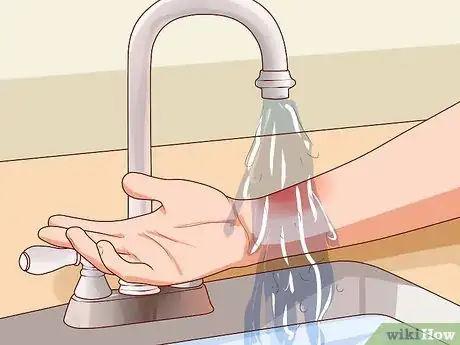
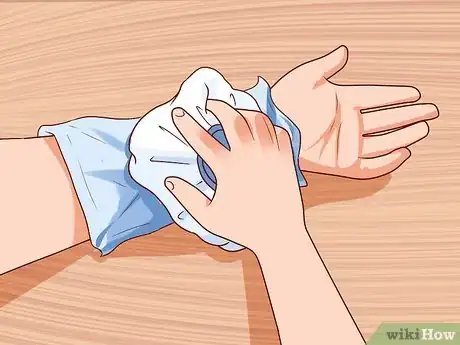


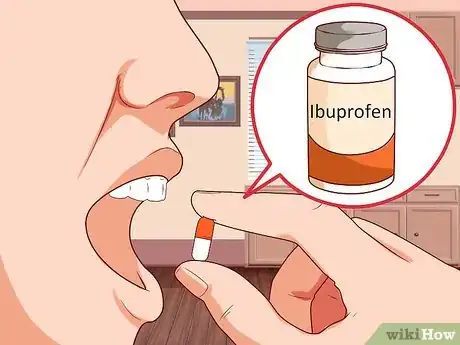
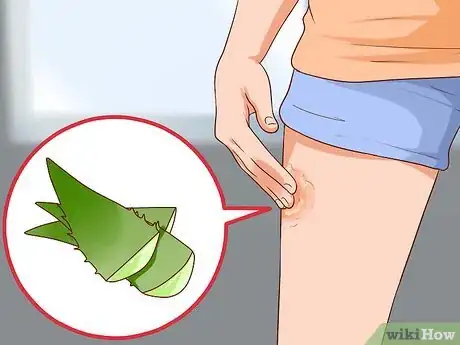
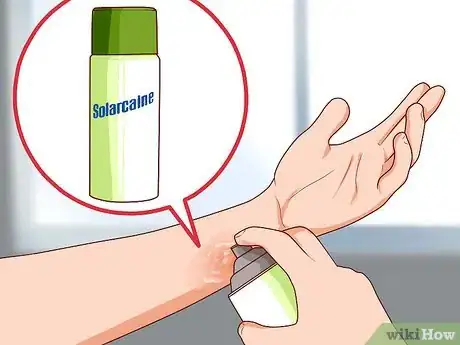
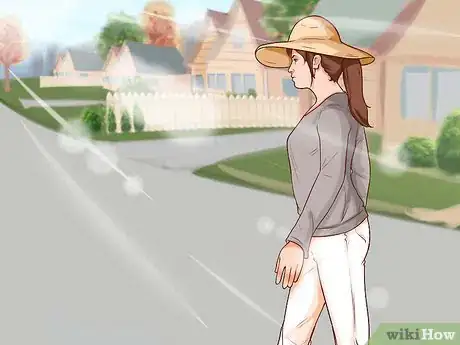

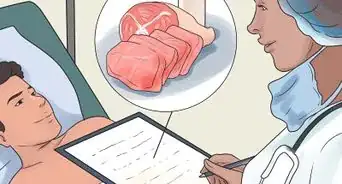

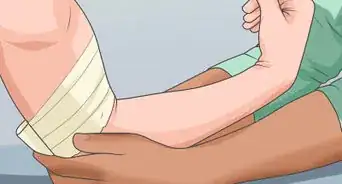
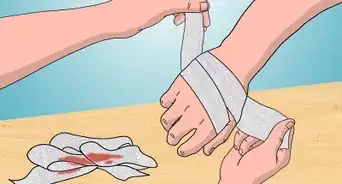
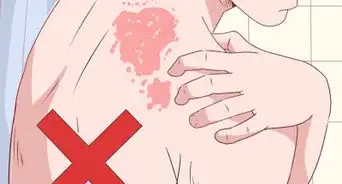





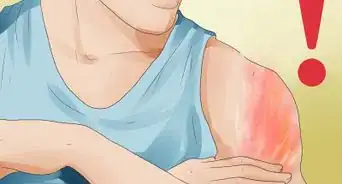

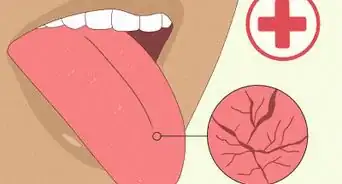







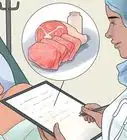






































Medical Disclaimer
The content of this article is not intended to be a substitute for professional medical advice, examination, diagnosis, or treatment. You should always contact your doctor or other qualified healthcare professional before starting, changing, or stopping any kind of health treatment.
Read More...